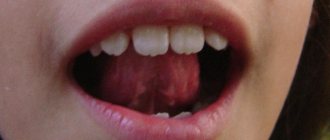Unfortunately, even parents who are not privy to medical subtleties are familiar with the opinion that a short frenulum of the tongue in a child is the cause of speech therapy problems.
Why "Unfortunately"? Because it is ignorance of the material that leads to a clear decision - the bridle needs to be trimmed! Do you remember in the film “Pokrovsky Gate” the characteristic female surgeon with her famous phrase “Cut!.. without waiting for peritonitis”? So the same thing often happens to the poor bridle. However, as experience shows, there is not always only one way out. Not every case of the so-called “short frenulum” requires radical measures.
What is a short frenulum of the tongue?
The frenulum is a thin partition that connects the tongue and the lower oral cavity. Normally, the frenulum is quite elastic, stretches well and is attached to the tongue in its middle part.
An abnormal structure may be the location of the frenulum closer to the edge of the tongue or even at its tip. In addition, a significant decrease in its elasticity, that is, its ability to stretch, is possible.
So in fact, the concept of “short bridle” is not entirely correct. Therefore, there is no clear solution to this issue.
What is the problem with the incorrect structure of the frenulum of the tongue?
In infants, an abnormal frenulum structure can cause difficulty sucking. In this case, the problem is solved in the maternity hospital by pruning. If the baby is still able to eat normally, doctors try to leave the situation alone, giving, as they say, time to grow. Indeed, in many cases, along with the growth of the jaw, the frenulum gradually stretches and takes on a normal shape.
In older children, a short hyoid frenulum creates some speech therapy difficulties:
- Difficulties arise with the pronunciation of hissing sounds.
- Correct reproduction of sonorants is not possible.
To pronounce the so-called upper lingual sounds, you need to raise the tip of your tongue upward. An insufficiently elastic bridle prevents this from being done.
However, it is very important to understand that it is not “responsible” for all speech problems. So if a child has a delay in speech development, syllables and sounds are “confused” in speech, a limited vocabulary or other problems, a short frenulum has nothing to do with it. The speech therapist will suggest effective methods of correction.
Exercises to stretch the frenulum of the tongue; consultation on speech therapy (senior group)
Memo for parents
How does the tongue frenulum affect a child’s speech?
The frenulum is a thin partition that connects the tongue and the lower oral cavity. Normally, the frenulum is quite elastic, stretches well and is attached to the tongue in its middle part.
An abnormal structure may be the location of the frenulum closer to the edge of the tongue or even at its tip. In addition, a significant decrease in its elasticity, that is, its ability to stretch, is possible.
What is the problem with the incorrect structure of the frenulum of the tongue?
In infants, an abnormal frenulum structure can cause difficulty sucking. In this case, the problem is solved in the maternity hospital by pruning. If the baby is still able to eat normally, doctors try to leave the situation alone, giving, as they say, time to grow. Indeed, in many cases, along with the growth of the jaw, the frenulum gradually stretches and takes on a normal shape.
In older children, a short hyoid frenulum creates some speech therapy difficulties:
- Difficulties arise with the pronunciation of hissing sounds.
- Correct reproduction of sonorants is not possible.
To pronounce the so-called upper lingual sounds, you need to raise the tip of your tongue upward. An insufficiently elastic bridle prevents this from being done.
However, it is very important to understand that it is not “responsible” for all speech problems. So if a child has a delay in speech development, syllables and sounds are “confused” in speech, a limited vocabulary or other problems, a short frenulum has nothing to do with it. The speech therapist will suggest effective methods of correction.
How to check if a child has a short frenulum
The presence of difficulties with the frenulum can be easily determined independently:
- Open your mouth slightly and place the tip of your tongue in the area behind your upper teeth. In this position, the place of attachment of the frenulum is clearly visible. If it is not “where it needs to be,” it is difficult to lift the tongue up.
- Pull your tongue forward. A short frenulum does not allow this to be done; in addition, the tip of the tongue visually looks forked
- Open your mouth and try to touch your upper lip with your tongue and lick it. Difficulties with the bridle make this movement difficult to perform.
Please note: sometimes a child cannot cope with these exercises not because there is something wrong with the frenulum. The cause may be weak muscles of the articulatory apparatus. Take a clean handkerchief and try to help your tongue. If resistance is felt when moving, then the problem is still in the hyoid frenulum.
Who to contact for help
Depending on the complexity of the situation, an orthodontist or speech therapist will help you cope with the problem. In any case, it makes sense to first get a consultation to decide what method of correction the child needs.
The dentist will carefully trim the frenulum, relieving the child of discomfort with one movement of his hand. However, recently doctors still recommend leaving surgical intervention as a last resort. An experienced speech therapist will offer a set of exercises and massage to stretch the frenulum.
Experts say that there are not many situations when the hyoid frenulum is absolutely unable to stretch. In almost all cases, a conservative approach achieves results.
A set of exercises for stretching the short frenulum of the tongue:
- "Painter". You must perform the exercise with your mouth wide open and a smile. The tip of the tongue should be drawn across the palate, starting from the teeth to the throat, while the lower jaw should not move. The exercise is accompanied by a rhyme:
- "Drum". Performed with an open mouth and a smile. The essence of the exercise is the repeated pronunciation of the letter [D]. It needs to be pronounced as clearly as possible. When pronouncing a sound, the tongue should rest against the upper teeth, and the mouth should be kept open. While doing this exercise, the child may involuntarily close his mouth; to prevent this from happening, you should hold a stick about 1 cm wide between his teeth, it could be a toothbrush handle or some other object.
- "Reach your nose." Just like in the previous exercises, you need to open your mouth and smile. The edge of the tongue must be pulled towards the nose and lowered towards the upper lip. Parents need to ensure that while performing these manipulations, the lips and lower jaw are motionless and the tongue is not compressed.
- "Swing". The child should smile and open his mouth, and on the count of “one or two,” alternately touch the upper and lower teeth. The lower jaw should remain motionless.
- "Football". The essence of the exercise is that you need to alternately press the tip of your tongue first to one cheek, then to the other, as if swinging a ball in your mouth.
- "Kitty". Children really like this exercise. You need to put some jam, ice cream or sour cream on a small plate and let the child lick the treat like a kitten.
- "Harmonic". The tongue should be pressed to the palate and, without lifting it, open and close the mouth.
- "Horse". Starting position: smile and open your mouth. Click your tongue like horses click. The tip of the tongue should not be pulled out or tucked down, and the lower jaw should remain motionless.
- "Fungus". The tongue should be pressed to the palate - this is the cap of the mushroom, and the frenulum is the leg, the lips should be kept in a smile.
- “Reach your chin.” In the process of performing the tenth exercise, the baby should reach with his tongue to the tip of the chin; the further he can reach, the greater the stretch of the frenulum.
How to do speech therapy massage for short tongue frenulum in children?
A special massage helps to lengthen the hyoid ligament very effectively. The child can do it independently or with the help of parents.
Massage to stretch the hyoid ligament:
- Using your thumb and index finger, you need to grab the tip of your tongue and lift it up. The mouth should be open during the massage. Using the fingers of the other hand, you need to move along the frenulum from bottom to top with stretching movements, as if pulling it out.
- The index and middle fingers should be placed under the tongue so that the frenulum is between them. Use your thumb to press on the front of the tongue and make outward lengthening movements. During such manipulation, the index and middle fingers should be motionless.
- The massage can be performed by simply stretching the tongue in different directions. Grasping the tip, carefully pull the tongue out.
Stretching the frenulum is an unpleasant and even slightly painful procedure for the child. There is no need to expect great results after two or three days of training; you should be patient and gradually move towards your goal.
How to check if a child has a short frenulum
The presence of difficulties with the frenulum can be easily determined independently:
- Open your mouth slightly and place the tip of your tongue in the area behind your upper teeth. In this position, the place of attachment of the frenulum is clearly visible. If it is not “where it needs to be,” it is difficult to lift the tongue up.
- Pull your tongue forward. A short frenulum does not allow this to be done; in addition, the tip of the tongue visually looks forked
- Open your mouth and try to touch your upper lip with your tongue and lick it. Difficulties with the bridle make this movement difficult to perform.
Please note: sometimes a child cannot cope with these exercises not because there is something wrong with the frenulum. The cause may be weak muscles of the articulatory apparatus. Take a clean handkerchief and try to help your tongue. If resistance is felt when moving, then the problem is still in the hyoid frenulum.
Who to contact for help
Depending on the complexity of the situation, an orthodontist or speech therapist will help you cope with the problem. In any case, it makes sense to first get a consultation to decide what method of correction the child needs.
The dentist will carefully trim the frenulum, relieving the child of discomfort with one movement of his hand. However, recently doctors still recommend leaving surgical intervention as a last resort. An experienced speech therapist will offer a set of exercises and massage to stretch the frenulum.
Experts say that there are not many situations when the hyoid frenulum is absolutely unable to stretch. In almost all cases, a conservative approach achieves results.
Parents can evaluate the pros and cons of different approaches on their own.
Surgical method:
- A quick, radical solution to the problem.
- The operation is performed using anesthesia.
- The healing process takes some time and is uncomfortable.
- Dietary restrictions due to surgery.
- It is advisable to maintain vocal rest for several days.
- Psychological trauma in the child is possible.
- After the operation, classes with a speech therapist are necessary to correct sound pronunciation.
Frenum stretching method:
- Conservative, does not cause psychological difficulties in the child.
- Effective in most cases.
- Does not require changes to your usual routine.
- It takes some time (several months).
- Requires discipline and regular practice.
In any case, to resolve the issue, you need to consult a speech therapist.
Exercises are an alternative to surgical frenulum trimming
A modern list of speech therapy manipulations aimed at stretching the frenulum located under the tongue area has proven itself to be a very effective and affordable method. This technique has been used by many children and parents, and in the vast majority of cases, the use of such manipulations made it possible to achieve the desired result without resorting to surgical intervention. Experts note that such events become effective only if they are carried out correctly and regularly. Each of the procedures must be performed by the child in full and exactly as recommended by the specialist, since otherwise their effectiveness is not guaranteed.
What is articulatory gymnastics and its meaning
According to the recommendations, the basic rules for conducting articulation exercises include:
- slow, no rush and maximum output;
- good mood, smile and wide open mouth;
- The exercise should be alternated with rest, since such exercises
- are a serious physical activity.
Rules for performing exercises for the frenulum
Some of the most popular activities include the following.
- "Painters".
- "Drums".
- "Reaching for the nose."
- "Swing".
- "Football".
- "Kitty".
- "Horse".
- "Harmonic".
- "Reaching for the chin."
- "Fungus".
Each of the above manipulations has its own specifics and affects the stretching of the frenulum of the tongue to varying degrees. That is why experts recommend using them in combination.
Description of basic exercises for the frenulum











